The Relationship between the Five Elements
The five elements of wood, fire, earth, metal, and water are not isolated; rather they work closely together and have their own internal orders and patterns. The rules that govern the five elements include a mutual generation cycle, a mutual restriction cycle, over restriction, reverse restriction and balance between generation and restriction.
Mutual generation cycle
This cycle refers to the manner in which the elements create one another. Wood easily burns and makes a fire. Fire produces ash, creating earth. The earth contains mineral from which metal is mined and extracted. When metal is heated and cooled, water droplets will be found over the metal as a result of condensation. Thus, metal creates water. Water promotes the growth of trees, which are wood. The cycle is cyclic and continually gives rise to change and transformation. (See figure 1.)
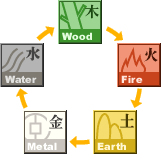 |
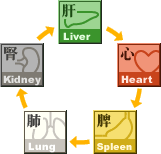 |
Figure 1.
This cycle shows how the five elements produce one another |
Figure 2.
This cycle shows how the five organs promote one another |
Index:  Generates Generates |
The Chinese word "sheng" for "generate" incorporates several other meanings such as create, promote, nurture, support and enhance. The "generation" of the five elements in nature can also be applied to the body. This relationship is sometimes referred to as a mother-child relationship because only a mother can give birth to a baby. For example, fire is the mother of earth since fire creates earth. Correspondingly in the body, the heart (which has a fire element) is the mother of the spleen (earth element) because the heart supports and promotes spleen function. (See Table 1.) If heart function is deficient, the spleen will be affected. According to TCM thinking, a heart deficiency cannot sufficiently rule the blood. Therefore, the spleen cannot perform its normal transformation of qi and blood and disharmony results. This disharmony may be mild, but in severe cases, it can lead to disease.
Mutual restriction cycle
This cycle refers to the manner in which the elements restrict and control one another. Wood breaks up the soil and depletes the earth's nutrients, thus controlling earth. Earth contains water in many places, and as dam prevents flooding, earth controls water. Water extinguishes fire, and therefore, controls its spread. Fire controls metal by its ability to melt it. Metal can be made into an axe that cuts wood into pieces, thus controlling wood. The control repeats in a cyclic fashion and provides an opposite force to balance the generative power. The generation and restriction properties of the five elements hold each other in check, preventing over-functioning. (See figure 3. and figure 4.)
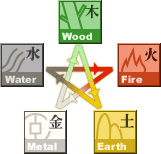 |
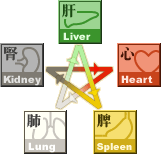 |
Figure 3.
This cycle shows how the five elements restrict one another |
Figure 4.
This cycle shows how the five organs restrict one another |
Index:  restricts restricts |
Over-restriction
The Chinese word for restriction, "ke" means "inhibition" or "winning over". In nature, wood controls the earth. (See figure 3.) In the body, the liver (a wood element) controls the spleen (an earth element) and inhibits its functions in a balanced manner. If the liver's function becomes excessive, there will be over-restriction of spleen function causing an imbalance in the body. This happens because excessive liver function produces fire, which in turns affects the smooth flow of qi. Without good qi flow to start, the spleen cannot successfully transform food into more qi.
Reverse restriction (insufficient original restriction)
If the enemy is too strong, the controlling element itself becomes controlled in a reverse manner (i.e. the original restriction is insufficient). When wood is too strong and its controlling metal axe is too blunt, the axe cannot cut the wood and may even break as a result of the rebound force if an attempt is made to chop it. This illustrates reverse restriction because the wood is able to restrict metal, which is not usually the case. In our body, if the spleen functions excessively, its controlling liver will also be restricted in a reverse manner. The excessive spleen function will produce heat and dampness, which doesn't have a sufficient release in the body. The constrained damp heat will heat up the liver and the gall bladder. When this occurs, the gall bladder can no longer properly regulate bile secretion, and disease occurs.
Balance between generation and restriction
A famous TCM physician Zhang JingYue (1563-1640 AD) said, "The mechanism of creation cannot do without promotion. Neither can it do without control. If there is no promotion, there will be no development and growth. If there is no control, the unbalanced excitement will be harmful. It is necessary to have control inside promotion and to have promotion inside control, so that everything can operate continuously, in both a complementary and opposite manner."
Balance between generation and restriction is important for normal transformation of the five elements. Each element is under the influence of the other four in some way. Wood generates fire and water generates wood. On the other hand, wood inhibits earth, but itself is inhibited by metal. In this way, all five elements establish an intricate homeostasis in nature. This wisdom has also been applied to TCM by incorporating the theory of the five elements into health maintenance strategies, which have been successful for thousands of years. (See figure 5.)
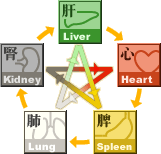 |
Figure 5.
Combined generation & restriction cycle
Index:  Generates Generates
Index:  restricts restricts |
|